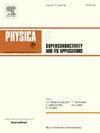Quantum criticality of type-I and critically tilted Dirac semimetals
IF 1
3区 物理与天体物理
Q4 PHYSICS, APPLIED
Physica C-superconductivity and Its Applications
Pub Date : 2025-03-12
DOI:10.1016/j.physc.2025.1354687
引用次数: 0
Abstract
We investigate the universality of an Ising symmetry breaking phase transition of tilted two-dimensional Dirac fermions, in the type-I phase as well as at the Lifshitz transition between a type-I and a type-II semimetal, where the Fermi surface changes from point-like to one with electron and hole pockets that touch at the overtilted Dirac cones. We compute the Landau damping of long-wavelength order parameter fluctuations by tilted Dirac fermions and use the resulting IR propagator as input for a renormalisation-group analysis of the resulting Gross–Neveu–Yukawa field theory. We first demonstrate that the criticality of tilted type-I fermions is controlled by a line of fixed points along which the poles of the renormalised Green function correspond to an untilted Dirac spectrum with varying anisotropy of Fermi velocities. At the phase transition the Lorentz invariance is restored, resulting in the same critical exponents as for conventional Dirac systems. The multicritical point is given by the endpoint of the fixed-point line. It can be approached along any path in parameter space that avoids the fixed point line of the critical type-I semimetal. We show that the critical exponents at the Lifshitz point are different and that Lorentz invariance is broken.
i型和临界倾斜狄拉克半金属的量子临界性
我们研究了倾斜二维狄拉克费米子在i型相以及i型和ii型半金属之间的Lifshitz跃迁中的伊辛对称破缺相变的普遍性,其中费米表面从点状变为在倾斜狄拉克锥上接触的电子和空穴口袋。我们计算了倾斜狄拉克费米子对长波长阶参量波动的朗道阻尼,并使用所得的红外传播子作为输入,对所得的Gross-Neveu-Yukawa场论进行重整化群分析。我们首先证明了倾斜的i型费米子的临界是由一条固定点控制的,沿着这条固定点,重归一化格林函数的极点对应于具有不同费米速度各向异性的未倾斜狄拉克谱。在相变时,恢复了洛伦兹不变性,从而得到与传统狄拉克系统相同的临界指数。多临界点由不动点线的端点给出。它可以沿着参数空间中避开临界i型半金属固定点线的任何路径逼近。我们证明了在Lifshitz点的临界指数是不同的,并且洛伦兹不变性被打破。
本文章由计算机程序翻译,如有差异,请以英文原文为准。
求助全文
约1分钟内获得全文
求助全文
来源期刊
CiteScore
2.70
自引率
11.80%
发文量
102
审稿时长
66 days
期刊介绍:
Physica C (Superconductivity and its Applications) publishes peer-reviewed papers on novel developments in the field of superconductivity. Topics include discovery of new superconducting materials and elucidation of their mechanisms, physics of vortex matter, enhancement of critical properties of superconductors, identification of novel properties and processing methods that improve their performance and promote new routes to applications of superconductivity.
The main goal of the journal is to publish:
1. Papers that substantially increase the understanding of the fundamental aspects and mechanisms of superconductivity and vortex matter through theoretical and experimental methods.
2. Papers that report on novel physical properties and processing of materials that substantially enhance their critical performance.
3. Papers that promote new or improved routes to applications of superconductivity and/or superconducting materials, and proof-of-concept novel proto-type superconducting devices.
The editors of the journal will select papers that are well written and based on thorough research that provide truly novel insights.

 求助内容:
求助内容: 应助结果提醒方式:
应助结果提醒方式:


